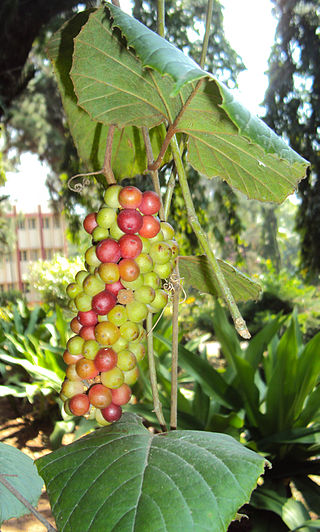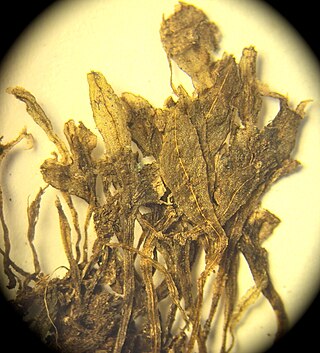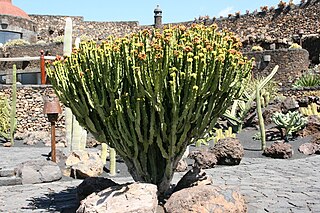
The Vitaceae are a family of flowering plants, with 14 genera and around 910 known species, including common plants such as grapevines and Virginia creeper. The family name is derived from the genus Vitis.

Vitis riparia Michx, with common names riverbank grape or frost grape, is a vine indigenous to North America. As a climbing or trailing vine, it is widely distributed across central and eastern Canada and the central and northeastern parts of the United States, from Quebec to Texas, and eastern Montana to Nova Scotia. There are reports of isolated populations in the northwestern USA, but these are probably naturalized. It is long-lived and capable of reaching into the upper canopy of the tallest trees. It produces dark fruit that are appealing to both birds and people, and has been used extensively in commercial viticulture as grafted rootstock and in hybrid grape breeding programs.

Guizotia abyssinica is an erect, stout, branched annual herb, grown for its edible oil and seed. Its cultivation originated in the Eritrean and Ethiopian highlands, and has spread to other parts of Ethiopia. Common names include noog/nug ; niger, nyger, or nyjer seed ; ramtil or ramtilla; inga seed; and blackseed.

The Abyssinian genet, also known as the Ethiopian genet, is a genet species native to Ethiopia, Eritrea, Somalia, Sudan, and Djibouti. It is listed as Data Deficient on the IUCN Red List. It is one of the least-known genet species.

Juniperus procera is a coniferous tree native to mountainous areas in Africa and the Arabian Peninsula. It is a characteristic tree of the Afromontane flora.

Anthyllis vulneraria, the common kidneyvetch, kidney vetch or woundwort is a medicinal plant native to Europe. The name vulneraria means "wound healer".

Ampelocissus is a genus of Vitaceae having 90 or more species found variously in tropical Africa, Asia, Central America, and Oceania. The type species, A. latifolia, was originally treated under its basionym, Vitis latifolia, and was collected from the Indian subcontinent.
Exotheca is a monotypic genus of African and Southeast Asian plants in the grass family.
Ampelocissus africana is a type of vine that is woody, or liana of the grape family, bearing edible fruit. It is native to habitats in, and around forested areas in Guinea, Ivory Coast, Nigeria, Cameroon, Chad, Central African Republic, Sudan, Kenya, Rwanda, Burundi, Tanzania, Malawi, Zambia, Mozambique, Zimbabwe and Botswana. It was originally described botanically in 1790 by João de Loureiro as Botria africanus, which is the basionym for its treatment here under Ampelocissus.
Ampelocissus gracilipes, also known as abourbee (Akan-Twi), is a climbing vine or liana in the Grape family of tropical western Africa, in densely vegetative, forested areas.

Jensenia spinosa is a dioicous bryophyte plant in the liverwort family Pallaviciniaceae. It is the only African member of the genus Jensenia, and generally occurs at high elevations. It is widespread but scarce, and has been found in South Africa, Malawi, Tanzania, Rwanda, the Democratic Republic of the Congo, as well as the islands of Mauritius, Réunion and Saint Helena.

Vitis sinocinerea, commonly known as the lobular grape or small-leaved grape, is a species of climbing vine in the grape family ranging widely over much of the Chinese mainland as well as Taiwan. In Chinese it is known as xiao ye pu tao, which can be translated as small-leaved grape. Its natural habitat is within forested or shrubby hills.
Vitis silvestrii is a species of polygamo-dioecious plant in the grape family native to the forested slopes of western Hubei and southern Shaanxi in China from 300 to 1200 meters above sea level. Its flowers appear in May, males having abortive pistils

Vitis bryoniifolia is a prolific and adaptable, polygamo-dioecious species of climbing vine in the grape family native to China, where it is known as ying yu(Traditonal Chinese: 蘡薁 Simplified Chinese: 蘡薁), or hua bei pu tao. The variant form ternata is known as san chu ying yu (Traditional and Simplified Chinese: 三出蘡薁), meaning Three-Spiked-Leafed Ying Yu.

Bothriochloa bladhii is a Neotropic grass in the family Poaceae, found primarily in tropical Africa, and tropical and temperate Asia, and Australia. The type specimen was collected from China by Finnish botanist Peter Johan Bladh. The name of Bladh is honored in the specific epithet.

Metroxylon vitiense is a species of flowering plant in the family Arecaceae, endemic to the islands of Fiji, Ovalau, and Vanua Levu in Fiji. There is only one confirmed occurrence of M. vitiense on Vanua Levu, just outside Savusavu. Despite it being considered a threatened species by the IUCN, as of February 2013 M. vitiense was still unprotected by Fijian regulations and international legislation. It has also been reported from the nearby islands of Wallis and Futuna.

Vachellia abyssinica, the flat top acacia, is a tree up to 16 m tall.

Euphorbia abyssinica, commonly known as the desert candle or candelabra spurge, is a species of plant in the family Euphorbiaceae. E. abyssinica is endemic to Ethiopia, Somalia, Sudan and Eritrea. It was first described in 1791, by the German botanist Johann Friedrich Gmelin. In its native habitat, it can grow up to 10 m (33 ft) tall. The woody stem is used for firewood and as timber in roofing, furniture and other items, and the sap is used in traditional medicine. It is also cultivated as an ornamental house plant.

Rosa abyssinica is the only rose native to Africa. Europeans first learned of the rose in the writings of 19th-century Scottish botanist Robert Brown. Rosa abyssinica is included in the genus Rosa, and the family Rosaceae. No subspecies are listed in the Catalogue of Life.

Lippia abyssinica, or koseret, is a species of flowering plant in the verbena family, Verbenaceae. It is endemic to Ethiopia but cultivated throughout tropical African countries. The specific epithet abyssinica derives from Latin and means 'of or from Ethiopia (Abyssinia)'.















